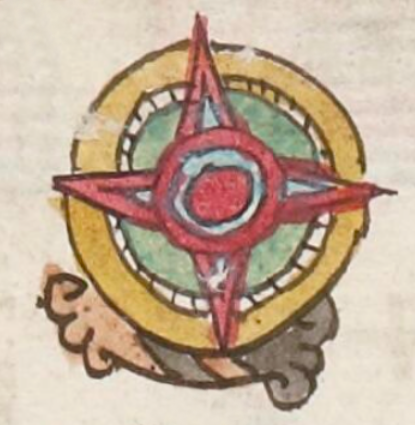tonatiuh cualo (TR31r)
This compound glyph for the personal name of a warrior, Tonatiuh Cualo (or Tonatiuh Icualo, Icualoca in Tonatiuh, etc., Eclipse of the Sun), includes a somewhat streamlined sign for "sun" (tonatiuh) and, showing a bit from behind the sun, a stone (tetl) with the standard curly ends and alternating, wavy, purple and terracotta-colored diagonal stripes. The qunicunx sun sign, in frontal view, is painted with the usual concentric circles and four points. The colors are, from outside in, yellow, white (segmented), green, red, and blue.
Stephanie Wood
The title for this glyph derives from the explanation in Spanish that refers to the eclipse and from consulting our Online Nahuatl Dictionary or appropriate vocabulary in Nahuatl. The presence of a stone may relate to the covering and darkening (conceived of as being "eaten" in Nahuatl) of the sun during an eclipse, a semantic contribution rather than a phonetic one. If there is a phonetic contribution (-te-), then the title for the glyph is probably incorrect. If there is a possessor (e.g., Icualo) in this phrase for eclipse, "its being eaten," then the superimposition of the sun over the rock could be a visual possessive. (See the discussion of Whittaker's take on Cuauhtinchan.)
Eloise Quiñones Keber (Codex Telleriano-Remensis, 1995, 215) interprets the name of the warrior in the contextualizing image as Tlacateotl ("Divine Lord"), the second ruler of Tlatelolco. She identifies the mound he stands on as akin to the glyph for the place name Tlatelolco. If this analysis is correct, then perhaps the stone (tetl) is a phonetic indicator for (teotl) (divinity). Although this is a full sun, a half sun can be a logogram for teotl.
Stephanie Wood
eclise del sol
eclipse del sol
Stephanie Wood
ca. 1550–1563
Jeff Haskett-Wood
Photograph by Robert Haskett, Sala Mexica, Museo Nacional de Antropología e Historia, Mexico City, summer 2005.

tonatiuh cualo, eclipse of the sun, https://nahuatl.wired-humanities.org/content/tonatiuh-cualo
Eclipse del Sol
Stephanie Wood
Telleriano-Remensis Codex, folio 31 recto, MS Mexicain 385, Gallica digital collection, https://gallica.bnf.fr/ark:/12148/btv1b8458267s/f87.item.zoom
The non-commercial reuse of images from the Bibliothèque nationale de France is free as long as the user is in compliance with the legislation in force and provides the citation: “Source gallica.bnf.fr / Bibliothèque nationale de France” or “Source gallica.bnf.fr / BnF.”




